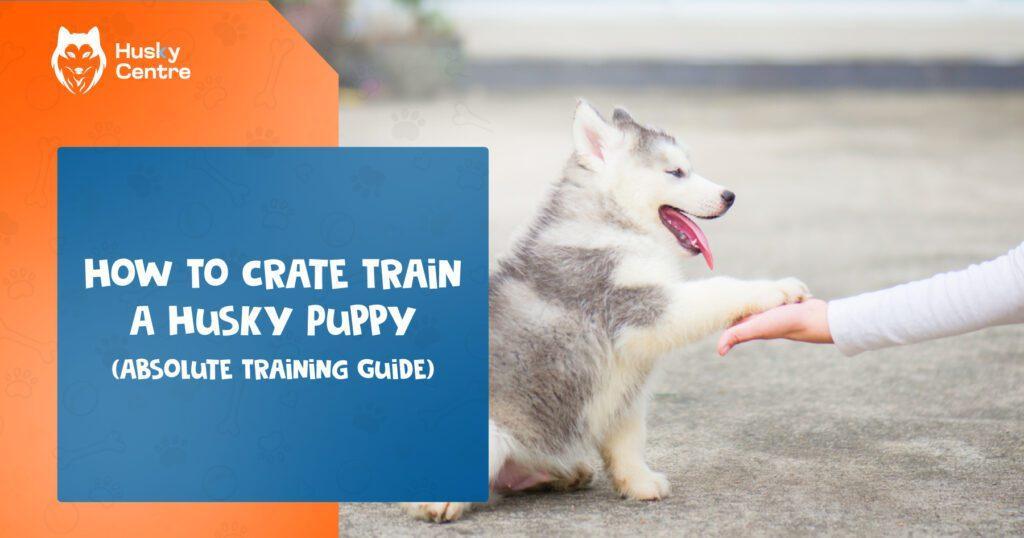To crate train a Husky puppy, start by introducing the crate as a positive space. Gradually increase the time spent inside.
Crate training a Husky puppy is crucial for their comfort and safety. A crate provides a secure environment, helping with housebreaking and preventing destructive behavior. Start by placing the crate in a quiet area and making it inviting with soft bedding and toys.
Allow your puppy to explore the crate at their own pace, using treats to encourage positive associations. Close the door for short periods, gradually extending the time as they become more comfortable. Consistency and patience are key to successful crate training. Establish a routine, providing regular breaks for play and bathroom needs. This method ensures your Husky feels secure and adapts well to their new home.
Importance Of Crate Training
Crate training a Husky puppy is essential for both the dog and the owner. It provides a safe space for your pup and helps with house training, reducing anxiety, and preventing destructive behavior. Understanding the importance of crate training will make the process smoother for everyone involved.
1. Safety And Security
A crate offers a safe and secure environment for your Husky puppy. It mimics a den, which is a natural instinct for dogs. This safe space can help reduce anxiety and stress. Your puppy will feel protected and calm in its crate.
2. House Training
Crate training is a highly effective method for house training. Dogs do not like to soil their sleeping area. This encourages your Husky puppy to hold it until they are let outside. Consistency in crate training will speed up the house-training process.
3. Preventing Destructive Behavior
Husky puppies are known for their high energy levels. Without proper supervision, they may chew on furniture or other household items. A crate keeps your puppy contained and prevents destructive behavior when you cannot supervise them directly.
4. Establishing A Routine
Crate training helps establish a daily routine for your Husky puppy. Regular feeding, playtime, and bathroom breaks will make your puppy more predictable. This routine is crucial for your puppy’s well-being and your peace of mind.
5. Travel And Vet Visits
A crate-trained puppy is easier to transport and handle during vet visits. Your puppy will already be familiar with the crate, making travel less stressful. This familiarity will also help during emergency situations.
Benefits Of Crate Training For Husky Puppies
Crate training is a valuable method for raising a well-behaved husky puppy. Huskies are known for their energy and intelligence. Crate training helps channel these traits positively. Let’s explore the benefits of crate training for husky puppies.
1. Creates a Safe Space
A crate provides a safe and secure space for your husky puppy. It mimics a den, which is comforting for them. Puppies often feel less anxious in their crate. It’s a place where they can relax and feel protected.
2. Assists with Potty Training
Crates are effective tools for potty training. Puppies are less likely to soil their sleeping area. This helps establish a routine for bathroom breaks. Consistent crate use can speed up potty training.
3. Prevents Destructive Behavior
Husky puppies are known for their chewing and digging. A crate helps prevent these behaviors when you are not around. It keeps your puppy safe from household hazards. It also protects your belongings from being chewed.
4. Facilitates Travel and Vet Visits
Crate training makes travel easier. Your husky will be familiar with the crate, reducing travel stress. It also helps during vet visits. A crate-trained puppy feels more secure in unfamiliar places.
5. Encourages Good Sleeping Habits
Crates help establish consistent sleeping patterns. Your husky will learn to sleep through the night. This benefits both the puppy and the owner. A well-rested puppy is happier and healthier.
6. Provides a Training Aid
A crate serves as a training tool. It helps teach your puppy boundaries. It also aids in teaching commands like “stay” and “settle.” Consistent crate training enhances overall obedience.
7. Builds Independence
Crate training encourages independence. Your husky learns to spend time alone without anxiety. This is crucial for their development. It helps prevent separation anxiety in the future.
Getting Started With Crate Training
Crate training your Husky puppy can be a rewarding experience for both you and your furry friend. It provides a safe space for your puppy and helps with house training. The process might seem daunting, but with the right approach, you can make it an enjoyable journey. This guide will help you get started with crate training, focusing on key steps to ensure success.
Choosing The Right Crate
Selecting the right crate is crucial for effective crate training. Your Husky puppy needs enough space to stand, turn around, and lie down comfortably. A crate that’s too big may encourage your puppy to use one corner as a bathroom, which defeats the purpose of crate training.
Consider the following tips when choosing a crate:
- Material: Crates come in various materials such as wire, plastic, and fabric. Wire crates offer better ventilation and visibility, while plastic crates provide a more enclosed space.
- Size: Measure your puppy’s height and length to ensure the crate size is appropriate. Most crates come with size guidelines based on dog breeds.
- Adjustability: An adjustable crate with a divider can grow with your puppy. This feature is cost-effective and ensures your puppy always has the right amount of space.
Here’s a table to help you choose the right crate size based on your Husky puppy’s age and weight:
| Age | Weight | Crate Size |
| 8-12 weeks | 10-15 lbs | 24 inches |
| 3-6 months | 15-30 lbs | 30 inches |
| 6-12 months | 30-50 lbs | 36 inches |
Introducing The Crate
Introducing the crate to your Husky puppy should be a positive experience. Start by placing the crate in a common area where your puppy spends most of its time. Leave the door open and let your puppy explore the crate at its own pace.
Follow these steps to make the introduction smooth:
- Make it inviting: Place a comfortable bed or blanket inside the crate. Add some of your puppy’s favorite toys to make it appealing.
- Use treats: Encourage your puppy to enter the crate by placing treats inside. Reward your puppy each time it goes in.
- Short sessions: Initially, keep the crate sessions short. Let your puppy spend a few minutes inside and gradually increase the duration.
Consistency is key in crate training. Use the crate for naps and bedtime to help your puppy associate it with rest. Avoid using the crate as a punishment to prevent negative associations.
With patience and positive reinforcement, your Husky puppy will soon love its crate and see it as a safe haven. Remember, the goal is to create a positive and comfortable space for your puppy.
Establishing A Routine
Crate training a Husky puppy involves setting a consistent routine. Establishing a routine helps your pup understand what to expect. This reduces anxiety and promotes positive behavior. A structured schedule is key to successful crate training.
Meal And Water Schedule
Creating a consistent meal and water schedule is crucial for your Husky puppy. Feed your puppy at the same times each day. Consistency helps establish a routine and makes bathroom breaks predictable. Here are some tips:
- Feed your puppy three times a day – morning, midday, and evening.
- Remove water an hour before bedtime to avoid nighttime accidents.
Here’s a sample feeding schedule:
| Time | Activity |
| 7:00 AM | Breakfast |
| 12:00 PM | Lunch |
| 6:00 PM | Dinner |
Stick to this schedule daily. Your puppy will quickly learn when to expect meals and water. This reduces anxiety and helps with crate training.
Scheduled Bathroom Breaks
Scheduled bathroom breaks are essential for crate training. Taking your puppy out at regular intervals helps prevent accidents. Here’s a suggested schedule:
- First thing in the morning
- After each meal
- Before bedtime
Follow this detailed schedule:
| Time | Activity |
| 7:00 AM | Bathroom break |
| 8:00 AM | Post-breakfast bathroom break |
| 12:30 PM | Post-lunch bathroom break |
| 6:30 PM | Post-dinner bathroom break |
| 10:00 PM | Last bathroom break before bed |
Keep this schedule consistent. Your puppy will learn quickly. This helps with crate training and reduces accidents inside the home.
Positive Reinforcement Techniques
Crate training a Husky puppy can be a rewarding experience. Positive reinforcement techniques make the process easier and more enjoyable for both you and your puppy. These methods help your Husky associate the crate with comfort and safety.
Using Rewards And Praise
Rewards and praise are powerful tools in crate training. They encourage your Husky to see the crate as a positive place.
Here are some effective ways to use rewards and praise:
- Treats: Offer small, tasty treats when your Husky enters the crate.
- Verbal praise: Use a happy tone and say “good boy” or “good girl” when they go inside.
- Petting: Gently pet your Husky to show affection and approval.
- Toys: Place favorite toys in the crate to make it more inviting.
To make the process even more effective, follow a simple reward system:
| Action | Reward |
| Entering the crate | Small treat and praise |
| Staying in the crate quietly | Verbal praise and petting |
| Exiting the crate calmly | Treat and playtime |
Consistency is key. Always reward good behavior immediately to reinforce the connection.
Avoiding Negative Reinforcement
Negative reinforcement can make crate training stressful for your Husky. Avoid using punishment or force, as it can create fear and anxiety.
Here are tips to avoid negative reinforcement:
- Never force your puppy into the crate: Forcing can cause fear.
- Avoid yelling: Loud noises can make your puppy scared of the crate.
- Don’t use the crate for punishment: The crate should be a safe place.
- Be patient: Give your puppy time to adjust to the crate.
Instead of punishment, focus on positive behaviors:
- Wait for your puppy to enter the crate on their own.
- Reward them immediately with treats and praise.
- Ignore whining; reward calm behavior instead.
Patience and consistency help your Husky feel safe and secure in their crate.
Gradual Crate Training Steps
Crate training a Husky puppy can be a rewarding experience. Gradual steps are key to ensuring your pup feels safe and comfortable. By following a structured approach, you can make the crate a positive space for your furry friend.
Short Intervals Initially
Begin by introducing your Husky puppy to the crate with short intervals. Keep the door open and allow your puppy to explore. Place treats or a favorite toy inside to create a positive association.
Follow these steps:
- Let your puppy enter the crate on their own. Avoid forcing them.
- Once inside, praise and reward with treats.
- Close the door for a few seconds, then open it. Gradually increase the time.
Repeat this process several times a day. Ensure each session is short and positive. This builds trust and helps your puppy feel secure.
Track your puppy’s progress:
| Session | Duration (Seconds) | Behavior |
| 1 | 10 | Calm |
| 2 | 20 | Relaxed |
| 3 | 30 | Comfortable |
Remember, patience is crucial. Short intervals initially set the foundation for successful crate training.
Leaving And Returning
Once your Husky puppy is comfortable with short intervals, start practicing leaving and returning. This teaches your puppy that you will always come back, reducing anxiety.
Follow these steps:
- Place your puppy in the crate with a treat or toy.
- Leave the room for a few minutes. Return calmly and praise your puppy.
- Gradually increase the duration you are away.
Ensure you vary the times you leave and return. This prevents your puppy from becoming anxious about a set routine.
Track the progress:
| Session | Duration (Minutes) | Behavior |
| 1 | 2 | Calm |
| 2 | 5 | Relaxed |
| 3 | 10 | Comfortable |
Consistency is key. Leaving and returning should be a positive experience. Always reward your puppy for staying calm and relaxed.
Nighttime Crate Training
Crate training a Husky puppy is essential for their safety and your peace of mind. Nighttime crate training can be challenging, but it’s a key part of the process. This guide will help you make nighttime crate training smoother for both you and your furry friend.
Crate Placement At Night
Crate placement at night is crucial for your puppy’s comfort. Place the crate in a quiet, low-traffic area. This helps the puppy feel safe and secure. A corner of your bedroom or a nearby room works well.
Ensure the crate is away from drafts. Cold air can make your puppy uncomfortable. Use a crate cover to create a den-like atmosphere. This can help your puppy feel more secure.
Here are some key points to consider for crate placement:
- Proximity to you: Being close can reduce anxiety.
- Safety: Keep the crate away from electrical cords and hazards.
- Comfort: Use soft bedding to make the crate cozy.
Temperature control is also important. Puppies can’t regulate their body temperature well. Ensure the room is warm enough. Use a small fan if it’s too hot.
Here’s a table summarizing the ideal crate placement factors:
| Factor | Importance |
| Proximity to Owner | High |
| Safety from Hazards | High |
| Comfortable Bedding | Medium |
| Temperature Control | Medium |
Nighttime Routine
A consistent nighttime routine helps your Husky puppy adjust to crate training. Establish a bedtime routine to signal it’s time to wind down. This can include a short walk or some playtime. End the routine with a potty break. This reduces the chances of nighttime accidents.
Use a calming voice and gentle petting to soothe your puppy before placing them in the crate. Provide a safe chew toy or a soft blanket. These items can comfort your puppy during the night.
Here’s a simple bedtime routine to follow:
- Playtime: Spend 10-15 minutes playing to burn off energy.
- Potty Break: Take your puppy outside for a bathroom break.
- Calm Time: Use a soothing voice and gentle petting.
- Crate Time: Place your puppy in the crate with a toy or blanket.
Be patient and consistent. Puppies may whine or cry at first. Avoid taking them out of the crate unless necessary. This teaches them to settle down and sleep through the night.
If your puppy wakes up, take them out for a quick potty break. Keep interactions minimal to avoid stimulating them. Return them to the crate quietly.
Handling Whining Or Anxiety
Crate training a Husky puppy can be a rewarding journey. It’s essential to address any whining or anxiety your puppy may exhibit. Handling these behaviors effectively helps your Husky feel safe and secure in their crate. Let’s dive into strategies for managing these common issues.
Addressing Whining Behavior
Whining is a typical behavior in puppies. It’s their way of communicating discomfort, boredom, or a need for attention. To handle whining, understand its root cause.
First, ensure all their basic needs are met:
- Food and Water: Ensure your puppy isn’t hungry or thirsty before crate time.
- Bathroom Breaks: Take them outside to relieve themselves before crating.
- Exercise: A tired puppy is less likely to whine. Engage in playtime or a short walk.
Once basic needs are addressed, follow these steps:
- Ignore the Whining: If your puppy whines, don’t immediately respond. Wait until they stop to avoid reinforcing the behavior.
- Reward Quiet Moments: When your puppy is quiet, offer a treat or praise. This teaches them that silence gets rewards.
- Use a Comfort Item: Place a favorite toy or blanket in the crate. It can soothe them and reduce whining.
Consistency is key. Stick to these steps, and over time, your Husky will learn that the crate is a safe and quiet space.
Dealing With Separation Anxiety
Separation anxiety occurs when a puppy feels stressed about being alone. This can lead to excessive whining or destructive behavior. Here’s how to manage it:
Start with Short Periods: Begin by leaving your puppy in the crate for short durations. Gradually increase the time as they become more comfortable.
Create Positive Associations: Make the crate a fun place. Use treats, toys, and praise to create a positive experience.
Practice Leaving and Returning: Leave the room for a few minutes, then return calmly. Repeat this several times a day to show that leaving is normal and not a cause for panic.
| Step | Description |
| Short Periods | Start with a few minutes and gradually increase. |
| Positive Associations | Use treats and toys to make the crate enjoyable. |
| Practice Leaving | Leave and return calmly to reduce anxiety. |
For severe cases, consider consulting a veterinarian or a professional dog trainer. They can offer tailored advice and support.
Troubleshooting Common Issues
Crate training a Husky puppy can be a rewarding experience, but it’s not without its challenges. Troubleshooting common issues can help ensure a smooth process. Let’s explore some typical problems you might face and how to overcome them.
Crate Escaping
Huskies are known for their intelligence and agility, which makes them excellent escape artists. If your Husky puppy keeps escaping the crate, consider these tips:
- Secure the crate properly: Ensure all latches and locks are fully engaged. Double-check for any weak spots where your puppy might push or pull to escape.
- Choose the right crate: A sturdy, well-built crate designed for dogs can prevent escapes. Avoid using crates meant for smaller or less active breeds.
- Supervise crate time initially: Keep an eye on your puppy while they are in the crate. This way, you can catch escape attempts and correct them immediately.
- Provide toys and distractions: Boredom can lead to escape attempts. Provide chew toys or puzzle toys to keep your Husky entertained.
If your Husky continues to escape, you might need to use a more secure crate. Consider these crate options:
| Crate Type | Features |
| Wire Crate | Durable, good ventilation, often collapsible |
| Plastic Crate | Enclosed, cozy, less visibility |
| Heavy-Duty Crate | Extra secure, suitable for escape artists |
Accidents In Crate
Accidents in the crate can be frustrating. If your Husky puppy is having accidents, it might be a sign of a few issues:
- Crate size: The crate might be too large. A properly sized crate should allow the puppy to stand, turn around, and lie down comfortably. Too much space can encourage one area as a bathroom.
- Potty schedule: Ensure you follow a consistent potty schedule. Puppies need frequent bathroom breaks, especially after meals and naps.
- Health issues: Sometimes, accidents are due to health problems. If accidents persist, consult your vet to rule out any medical conditions.
Implementing a regular potty schedule can help reduce accidents. Here’s a simple schedule to follow:
| Time | Activity |
| Morning | First potty break, breakfast, playtime |
| Mid-Morning | Second potty break, crate time |
| Afternoon | Lunch, potty break, playtime |
| Evening | Dinner, potty break, playtime, final potty break |
Consistency is key. Stick to the schedule and praise your puppy for going outside. This will reinforce good behavior and reduce crate accidents.
Graduating From Crate Training
Crate training a Husky puppy requires patience and consistency. The goal is to help your puppy see the crate as a safe, comfortable place. Once your puppy is comfortable, it’s time to think about graduating from crate training. This stage involves giving your puppy more freedom while ensuring they still see the crate as a safe space.
Gradual Freedom
Start by giving your Husky puppy short periods of freedom outside the crate. Begin with a few minutes, then gradually increase the time. Watch your puppy closely during these periods to ensure they don’t get into trouble.
Here are some steps to follow:
- Step 1: Allow your puppy to explore one room at a time. Close off other areas to limit their space.
- Step 2: Gradually open more rooms as your puppy becomes more trustworthy.
- Step 3: Always supervise your puppy when they’re out of the crate.
During this phase, keep the crate door open. This way, your puppy can return to it if they feel the need.
A sample schedule might look like this:
| Time | Activity |
| 8:00 AM | Breakfast in the crate |
| 9:00 AM | Supervised free time in one room |
| 10:00 AM | Nap time in the crate |
Remember: Consistency is key. Stick to a routine to help your puppy understand the boundaries.
Using Crate As Safe Space
Even after graduating from crate training, your Husky puppy should still see the crate as their safe space. This helps them feel secure and reduces anxiety.
To maintain this, follow these tips:
- Keep the crate door open: Allow your puppy to enter and exit as they please.
- Place treats and toys inside: This encourages your puppy to spend time in the crate.
- Use the crate during stressful times: If there’s a loud noise or you’re having guests over, guide your puppy to their crate.
Creating positive associations with the crate is crucial. Avoid using the crate as a form of punishment. Always ensure the crate remains a place of comfort and security.
Tip: Add a cozy blanket or a piece of your clothing to make the crate feel even more inviting.
By following these steps, your Husky puppy will continue to see the crate as their safe haven, even as they enjoy more freedom in your home.
Frequently Asked Questions
Is It Hard To Crate Train A Husky?
Crate training a Husky can be challenging. Huskies are independent and stubborn. Consistency and patience are crucial. Use positive reinforcement for best results.
How Do I Get My Husky Puppy To Stop Crying?
Ensure your Husky puppy feels safe and secure. Provide a comfortable space, regular exercise, and toys. Establish a consistent routine. Avoid rewarding crying with attention. Use positive reinforcement for quiet behavior.
How Do You Crate Train A Husky Puppy At Night?
Place the crate in your bedroom. Use a comfortable bed inside. Offer treats and toys. Maintain a consistent bedtime. Gradually increase crate time.
Is It Okay To Leave A Siberian Husky In A Crate?
Yes, it’s okay to crate a Siberian Husky for short periods. Ensure the crate is spacious and comfortable. Avoid extended confinement to prevent anxiety and boredom. Regular exercise and attention are crucial.
Conclusion
Crate training a Husky puppy takes patience and consistency. Follow the steps, and your puppy will feel secure. Remember to make the crate a positive space. With time, your Husky will see the crate as their safe haven. Happy training, and enjoy the journey with your new furry friend!


Meet Jarred, the heart and soul behind HukyCentre. With a deep affection for furry friends, he pours his passion into every word he writes. His genuine love for dogs shines through in his engaging and informative content. As a dedicated dog enthusiast, Jarred’s goal is to share valuable insights and tips that resonate with fellow dog lovers. Join Jarred on the journey as he celebrates the joy and companionship that dogs bring into our lives.



